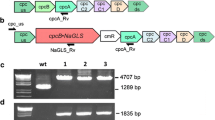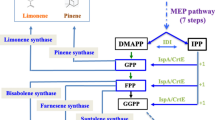Abstract
Cyanobacteria can be exploited as photosynthetic platforms for heterologous generation of terpene hydrocarbons with industrial application. However, the slow catalytic activity of terpene synthases (k cat = 4 s−1 or slower) makes them noncompetitive for the pool of available substrate, thereby limiting the rate and yield of product generation. Work in this paper applied transformation technologies in Synechocystis for the heterologous production of β-phellandrene (monoterpene) hydrocarbons. Conditions were defined whereby expression of the β-phellandrene synthase (PHLS), as a CpcB·PHLS fusion protein with the β-subunit of phycocyanin, accounted for up to 20 % of total cellular protein. Moreover, CpcB·PHLS was heterologously co-expressed with enzymes of the mevalonic acid (MVA) pathway and geranyl-diphosphate synthase, increasing carbon flux toward the terpenoid biosynthetic pathway and enhancing substrate availability. These improvements enabled yields of 10 mg of β-phellandrene per g of dry cell weight generated in the course of a 48-h incubation period, or the equivalent of 1 % β-phellandrene:biomass (w:w) carbon-partitioning ratio. The work helped to identify prerequisites for the efficient heterologous production of terpene hydrocarbons in cyanobacteria: (i) requirement for overexpression of the heterologous terpene synthase, so as to compensate for the slow catalytic turnover of the enzyme, and (ii) enhanced endogenous carbon partitioning toward the terpenoid biosynthetic pathway, e.g., upon heterologous co-expression of the MVA pathway, thereby supplementing the native metabolic flux toward the universal isopentenyl-diphosphate and dimethylallyl-diphosphate terpenoid precursors. The two prerequisites are shown to be critical determinants of yield in the photosynthetic CO2 to terpene hydrocarbons conversion process.










Similar content being viewed by others
Abbreviations
- dcw:
-
Dry cell weight
- DMAPP:
-
Dimethylallyl-diphosphate
- GPP:
-
Geranyl-diphosphate
- GPPS:
-
Geranyl-diphosphate synthase
- IPP:
-
Isopentenyl-diphosphate
- MEP:
-
2-C-Methyl-D-erythritol 4-phosphate
- MVA:
-
Mevalonic acid
- PHL:
-
β-Phellandrene
- PHLS:
-
β-Phellandrene synthase
References
Alonso-Gutierrez J, Chan R, Batth TS, Adams PD, Keasling JD, Petzold CJ, Lee TS (2013) Metabolic engineering of Escherichia coli for limonene and perillyl alcohol production. Metab Eng 19:33–41
Bar-Even A, Noor E, Savir Y, Liebermeister W, Davidi D, Tawfik DS, Milo R (2011) The moderately efficient enzyme: evolutionary and physicochemical trends shaping enzyme parameters. Biochemistry 50:4402–4410
Bentley FK, Melis A (2012) Diffusion-based process for carbon dioxide uptake and isoprene emission in gaseous/aqueous two-phase photobioreactors by photosynthetic microorganisms. Biotechnol Bioeng 109:100–109
Bentley FK, García-Cerdán JG, Chen HC, Melis A (2013) Paradigm of monoterpene (β-phellandrene) hydrocarbons production via photosynthesis in cyanobacteria. BioEnergy Res 6:917–929
Bentley FK, Zurbriggen A, Melis A (2014) Heterologous expression of the mevalonic acid pathway in cyanobacteria enhances endogenous carbon partitioning to isoprene. Mol Plant 7:71–86
Davies FK, Work VH, Beliaev AS, Posewitz MC (2014) Engineering limonene and bisabolene production in wild type and a glycogen-deficient mutant of Synechococcus sp. PCC 7002. Front Bioeng Biotechnol 2:21
Demissie ZA, Sarker LS, Mahmoud SS (2011) Cloning and functional characterization of β-phellandrene synthase from Lavandula angustifolia. Planta 233:685–696
Duetz WA, Bouwmeester H, van Beilen JB, Witholt B (2003) Biotransformation of limonene by bacteria, fungi, yeasts, and plants. Appl Microbiol Biotechnol 61:269–277
Eaton-Rye JJ (2011) Construction of gene interruptions and gene deletions in the cyanobacterium Synechocystis sp. strain PCC 6803. Methods Mol Biol 684:295–312
Farmer WR, Liao JC (2001) Precursor balancing for metabolic engineering of lycopene production in Escherichia coli. Biotechnol Prog 17:57–61
Fischer MJC, Meyer S, Claudel P, Bergdoll M, Karst F (2011) Metabolic engineering of monoterpene synthesis in yeast. Biotechnol Bioeng 108:1883–1892
Formighieri C, Melis A (2014a) Carbon partitioning to the terpenoid biosynthetic pathway enables heterologous β-phellandrene production in Escherichia coli cultures. Arch Microbiol 196:853–861
Formighieri C, Melis A (2014b) Regulation of β-phellandrene synthase gene expression, recombinant protein accumulation, and monoterpene hydrocarbons production in Synechocystis transformants. Planta 240:309–324
Formighieri C, Melis A (2015) A phycocyanin·phellandrene synthase fusion enhances recombinant protein expression and β-phellandrene (monoterpene) hydrocarbons production in Synechocystis (cyanobacteria). Metab Eng 32:116–124
Guenther JE, Melis A (1990) The physiological significance of photosystem II heterogeneity in chloroplasts. Photosynth Res 23:105–109
Harvey B, Benjamin G, Wright M, Quintana R (2010) High-density renewable fuels based on the selective dimerization of pinenes. Energy Fuels 24:267–273
Kim SW, Keasling JD (2001) Metabolic engineering of the nonmevalonate isopentenyl diphosphate synthesis pathway in Escherichia coli enhances lycopene production. Biotechnol Bioeng 72:408–415
Kirst H, Formighieri C, Melis A (2014) Maximizing photosynthetic efficiency and culture productivity in cyanobacteria upon minimizing the phycobilisome light-harvesting antenna size. Biochim Biophys Acta 1837:1653–1664
Kuroda H, Maliga P (2001a) Complementarity of the 16S rRNA penultimate stem with sequences downstream of the AUG destabilizes the plastid mRNAs. Nucleic Acids Res 29:970–975
Kuroda H, Maliga P (2001b) Sequences downstream of the translation initiation codon are important determinants of translation efficiency in chloroplasts. Plant Physiol 125:430–436
Lichtenthaler HK (2000) Sterols and isoprenoids. Biochem Soc Trans 28:785–789
Lindberg P, Park S, Melis A (2010) Engineering a platform for photosynthetic isoprene production in cyanobacteria, using Synechocystis as the model organism. Metab Eng 12:70–79
Livak KJ, Schmittgen TD (2001) Analysis of relative gene expression data using real-time quantitative PCR and the 2−∆∆CT method. Methods 25:402–408
Martin VJJ, Pitera DJ, Withers ST, Newman JD, Keasling JD (2003) Engineering a mevalonate pathway in Escherichia coli for production of terpenoids. Nat Biotechnol 21:796–802
Matthews PD, Wurtzel ET (2000) Metabolic engineering of carotenoid accumulation in Escherichia coli by modulation of the isoprenoid precursor pool with expression of deoxyxylulose phosphate synthase. Appl Microbiol Biotechnol 53:396–400
Mattoo AK, Edelman M (1987) Posttranslational palmitoylation of the chloroplast 32-kD herbicide-binding protein. Proc Natl Acad Sci USA 84:1497–1501
Melis A (2013) Carbon partitioning in photosynthesis. Curr Opin Chem Biol 17:453–456
Qin D, Fredrick K (2013) Analysis of polysomes from bacteria. Methods Enzymol 530:159–172
Rajaonarivony JI, Gershenzon J, Croteau R (1992) Characterization and mechanism of (4S)-limonene synthase, a monoterpene cyclase from the glandular trichomes of peppermint (Mentha × piperita). Arch Biochem Biophys 296:49–57
Sarria S, Wong B, Martin HG, Keasling JD, Peralta-Yahya P (2014) Microbial synthesis of pinene. ACS Synth Biol 3:466–475
Schilmiller AL, Schauvinhold I, Larson M, Xu R, Charbonneau AL, Schmidt A, Wilkerson C, Last RL, Pichersky E (2009) Monoterpenes in the glandular trichomes of tomato are synthesized from a neryl diphosphate precursor rather than geranyl diphosphate. Proc Natl Acad Sci USA 106:10865–10870
Stephens E, Ross IL, Hankamer B (2013) Expanding the microalgal industry—continuing controversy or compelling case? Curr Opin Chem Biol 17:444–452
Tracy N, Chen D, Crunkleton DW, Price GL (2009) Hydrogenated monoterpenes as diesel fuel additives. Fuel 88:2238–2240
Van Wagoner RM, Drummond AK, Wright JLC (2007) Biogenetic diversity of cyanobacterial metabolites. Adv Appl Microbiol 61:89–217
Williams JGK (1988) Construction of specific mutations in photosystem II photosynthetic reaction center by genetic engineering methods in Synechocystis 6803. Methods Enzymol 167:766–778
Zurbriggen A, Kirst H, Melis A (2012) Isoprene production via the mevalonic acid pathway in Escherichia coli (bacteria). BioEnergy Res 5:814–828
Author information
Authors and Affiliations
Corresponding author
Electronic supplementary material
Below is the link to the electronic supplementary material.
Rights and permissions
About this article
Cite this article
Formighieri, C., Melis, A. Sustainable heterologous production of terpene hydrocarbons in cyanobacteria. Photosynth Res 130, 123–135 (2016). https://doi.org/10.1007/s11120-016-0233-2
Received:
Accepted:
Published:
Issue Date:
DOI: https://doi.org/10.1007/s11120-016-0233-2




